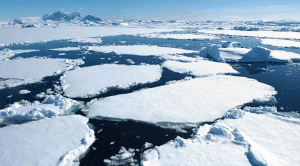 Arctic, what would you know about Arctic? Such as place with ice and snow in everywhere with the temperature -40 degree Celcius. It is suited to live in an icy place for a polar bear. Polar bears are marine mammals, they have more than two meters in length and weight with the white fur. Their fur is thick and made up of warm undercoat with longer hairs.
Arctic, what would you know about Arctic? Such as place with ice and snow in everywhere with the temperature -40 degree Celcius. It is suited to live in an icy place for a polar bear. Polar bears are marine mammals, they have more than two meters in length and weight with the white fur. Their fur is thick and made up of warm undercoat with longer hairs.
Besides, they have strong front paws that help when paddling in the water, and fur on the bottom of its feet that not only helps to keep them warm but also gives the polar bear extra grip when moving on the ice. In the Arctic, polar bears are the largest carnivores and also top of the food chain. Usually, polar bears use sea ice as a platform to hunt seals.
They are also hunting walrus, beluga whale, birds, and fish. They have an excellent sense of smell, they can smell them out from a considerable distance away. The facts, polar bears can reach speeds up to 40 kph (25 mph) on land and 10 kph (6 mph) in the water.
Polar Bear Evolution
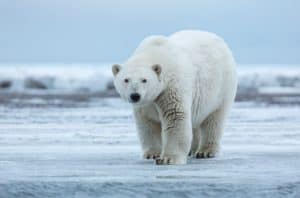 Ursus arctos, more widely known as the brown bear. Over thousands of years, this population of bears underwent further evolutionary change, adapting even more specialized traits for surviving the harsh polar environment.
Ursus arctos, more widely known as the brown bear. Over thousands of years, this population of bears underwent further evolutionary change, adapting even more specialized traits for surviving the harsh polar environment.
When life in the North demanded teeth better shaped for ripping apart seals than munching berries, the polar bear’s molar teeth changed significantly from those of the brown bear. The bears also grew white fur, which camouflaged them in their snow-covered surroundings and gave them a hunting advantage.
Scientists believe that at first these bears scavenged seal carcasses that had washed ashore, and gradually began to hunt the seals by waiting at the water’s edge as the seals surfaced to breathe. This is believed to be an important step in the evolution of a new subspecies of bear — Ursus maritimus or the polar bear.
See also:
- Endangered Animals in The Ocean
- Endangered Animals in The Great Barrier Reef
- Deep Ocean Ecosystems
- Animals in The Ocean Biome
- Decomposers of The Ocean
The Bear Species of The World
Refer the evolution of polar bear, a polar bear is one of the bear species in the world. There’re several bear species that we should know. Below these the information of 14 the bear species of the world.
1. Polar Bear
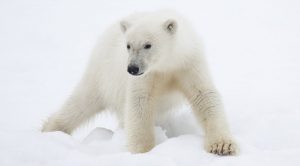 Polar bear (Ursus maritimus) in the first rank of the other species of bear. The Polar bear is the largest bear in the world and the largest terrestrial predator in the world.
Polar bear (Ursus maritimus) in the first rank of the other species of bear. The Polar bear is the largest bear in the world and the largest terrestrial predator in the world.
The Polar bear is the only bear to spend most of its time at sea, so the polar bear sometimes considered a marine mammal; like a walrus. Ursus maritimus Tyrannus is an extinct subspecies of polar bear, known from a single fragmentary ulna found in the gravels of the Thames at Kew Bridge, London.
It was named by the Finnish paleontologist Björn Kurtén in 1964 and is interpreted to represent a relatively large subadult individual: the ulna is estimated to have been 48.5 cm long when complete, recent studies only weigh in at 400 kg, for comparison modern subadult polar bear ulnae are 36–43 cm long.
2. Spectacled Bear
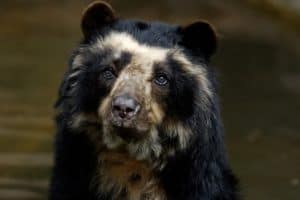 The spectacled bear is the only bear native to South America and it’s the only short-faced bear left in the world. Short-faced bears, also called tremarctine bears or running bears, were, up until about 15,000 years ago, the most common type of bear in the Americas and Europe.
The spectacled bear is the only bear native to South America and it’s the only short-faced bear left in the world. Short-faced bears, also called tremarctine bears or running bears, were, up until about 15,000 years ago, the most common type of bear in the Americas and Europe.
Its skull shape is very different from other bears, as you might expect from the fact that it’s a short-faced bear: its snout is shorter and rounder than any living bear. The name comes from its distinctive facial coloration, which sometimes (but not always) makes it look like the bear is wearing glasses.
All of the short-faced bears, which included the cave bear and Florida short-faced bear, were enormous, probably the largest carnivores on the planet at that time. The spectacled bear is a mid-sized bear, technically the largest carnivore in South America, though it mostly eats plants and fruits (fruits, cactus, bamboo, orchid bulbs).
3. Sun Bear
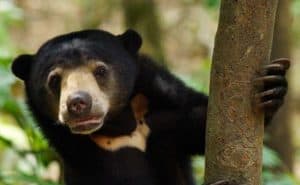 The sun bear is the smallest of all bears, which at around 1.4 meters (4.5 ft long) and weighing up to 100 lbs. They have short, sleek black fur with an orange-yellow horseshoe shape of color on their chest.
The sun bear is the smallest of all bears, which at around 1.4 meters (4.5 ft long) and weighing up to 100 lbs. They have short, sleek black fur with an orange-yellow horseshoe shape of color on their chest.
In some folktales, it is said that this shape represents the rising sun. They are also known as honey bears and Malayan sun bears. They eat consists of lizards, birds, rodents, insects, termites, fruit and honey.
The sun bear is handy for tearing open trees where insect and bee nest can be found and slurped up using their extra long tongue. They live in tropical temperatures; so they can be found in the tropical rainforest of southeastern Asia. They do not need to hibernate because of they able to mate at any time of year. Male and female sun bears live together while raising the cubs (child). Usually, they have two cobs at a time and care for them until two years.
4. Sloth Bear
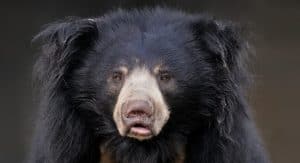 The sloth bear (Melursus ursinus), a smallish bear and native of India. The sloth bear is the first insectivorous bear on our list, specializing in termites, though it also adores honeycomb and a few kinds of fruits (mango, jackfruit, wood apple).
The sloth bear (Melursus ursinus), a smallish bear and native of India. The sloth bear is the first insectivorous bear on our list, specializing in termites, though it also adores honeycomb and a few kinds of fruits (mango, jackfruit, wood apple).
They have very thick fur, despite being tropical animals, and have specializations for eating insects (a hard palate for crushing them, strong claws for digging, that kind of thing). They also have long floppy ears.In the wild, sloth bears are highly aggressive; they’ll attack humans without any real provocation, though they typically don’t hunt or eat them.
5. American Black Bear
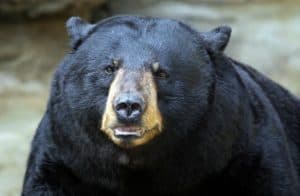 American black bear is the smallest of the three bears species found in North America, and are found only in North America. Black bear fur is usually a uniform color except for a brown muzzle and light markings that sometimes appear on their chests. Eastern populations are usually black in color while western populations often show brown, cinnamon, and blond coloration in addition to black
American black bear is the smallest of the three bears species found in North America, and are found only in North America. Black bear fur is usually a uniform color except for a brown muzzle and light markings that sometimes appear on their chests. Eastern populations are usually black in color while western populations often show brown, cinnamon, and blond coloration in addition to black
. Black bears with white-bluish fur are known as Kermode (glacier) bears and these unique color phases are only found in coastal British Columbia, Canada. Their population is estimated that there are at least 600.000 black bears in North America.
They are primarily found in forested areas with thick ground vegetation in habitat types, and they will sometimes forage in fields or meadows. Most black bears hibernate depending on local wheater conditions and availability of food during the winter months. Female black bears can birth to up to six cubs, and usually breed every other year, and they will raise the cubs for about 18 months.
6. Lousiana Black Bear
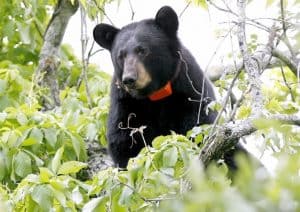 The Louisiana black bear (Ursus Americanus Luteolus), recognized subspecies of black bears in North America. They are living in Louisiana, lower Missipi and eastern Texas. Theirs weigh from 250 to over 400 pounds with body length up to 6 feet. Males may range over 100 square miles seeking food, refuge, den sites, and mates. Females are smaller and range much less.
The Louisiana black bear (Ursus Americanus Luteolus), recognized subspecies of black bears in North America. They are living in Louisiana, lower Missipi and eastern Texas. Theirs weigh from 250 to over 400 pounds with body length up to 6 feet. Males may range over 100 square miles seeking food, refuge, den sites, and mates. Females are smaller and range much less.
Louisiana black bears survive mostly on berries and acorns – they are not active predators. Currently, the scientists estimate that between 500 and 750 Louisiana black bears roam the United States, approximately double the population size at the time of listing.
7. Florida Black Bear
 The Florida black bear (Ursus Americanus Floridanus) is another a subspecies of the American black bear. The Florida bear is the state largest native land mammal. The average weight of a Florida black bear is 350 pounds for males and 200 pounds for females. They are generally 4.5 to 6.5 feet long and approximately 3 feet tall when standing on all four feet.
The Florida black bear (Ursus Americanus Floridanus) is another a subspecies of the American black bear. The Florida bear is the state largest native land mammal. The average weight of a Florida black bear is 350 pounds for males and 200 pounds for females. They are generally 4.5 to 6.5 feet long and approximately 3 feet tall when standing on all four feet.
Florida black bears can be found in a variety of habitats throughout Florida, including mixed hardwood hammocks, cabbage palm forests, pine flat woods, uplands such as sandhills and sand-pine scrub and forested wetlands. They are excellent tree climbers and sustain themselves mostly on berries, fruits, and nuts with the occasional insect component and even meat such as opossum and carrion.
8. Giant Panda
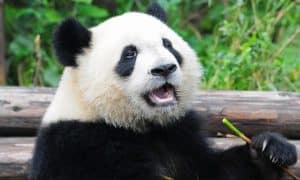 The panda is like the other bears with black and white coloring makes them one of the best-known species in the world. The big pandas can reach 1.9 m in height and weigh around 220-250 lbs and it weighs up to 350 lbs. Gian panda lives in bamboo forests in mountain regions of western China.
The panda is like the other bears with black and white coloring makes them one of the best-known species in the world. The big pandas can reach 1.9 m in height and weigh around 220-250 lbs and it weighs up to 350 lbs. Gian panda lives in bamboo forests in mountain regions of western China.
They can be found in Sichuan province but they also in the neighboring provinces of Shanxi and Gansu. The giant panda does not always eat bamboo, they are omnivores which means their eating of both vegetation and meat. But bamboo by far is their favorite food. The facts giant pandas are shy animals that prefer to live alone.
Giant pandas could detect the scent for other giant pandas using by their heightened sense of smell. Pandas do not hibernate during winter months, but they may migrate short distances to lower elevations. Every March to May in spring season the giant pandas do mating and give birth five months later in a nest of bamboo. Baby giant pandas are born blind and they raised by her mother until 18 months.
9. Spirit Bear
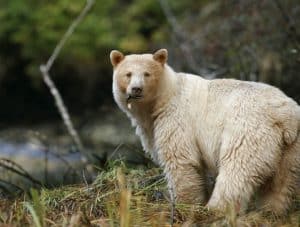 The spirit bear (Ursus americanus kermodei), they are another subspecies too of the North American black bear with a rare recessive gene that makes their fur white or cream. They also found in the Great Bear Rainforest on British Columbia;s North and central coast. Now, the number of spirit bears living in the corner of the world are no more than about 400 individuals.
The spirit bear (Ursus americanus kermodei), they are another subspecies too of the North American black bear with a rare recessive gene that makes their fur white or cream. They also found in the Great Bear Rainforest on British Columbia;s North and central coast. Now, the number of spirit bears living in the corner of the world are no more than about 400 individuals.
The spirit bears are omnivores, they mostly eat fish and berries, but also deer, moose fawns, insects, plants, fruits, nuts, etc. The spirit bear depends on salmon runs in the fall to fatten themselves up for the long winter hibernation, where they can go without food for up to 7 months. During the late spring, they do mating and cubs are born in January or February. Their mother raised them about 8 months.
10. Grizzly Bear
 The Grizzly Bear latin name is Ursus arctos horribilis because the naturalist who named it assumed it was called the “grisly” bear. These bear are powerful animals and that be found in certain areas of Canada and the United States. Grizzly bears can weigh from 300 to 1,500 pounds and stand as tall as eight feet. Even though they can run up to 35 miles per hour.
The Grizzly Bear latin name is Ursus arctos horribilis because the naturalist who named it assumed it was called the “grisly” bear. These bear are powerful animals and that be found in certain areas of Canada and the United States. Grizzly bears can weigh from 300 to 1,500 pounds and stand as tall as eight feet. Even though they can run up to 35 miles per hour.
The grizzly bear looks different than other bears because of its long curved claws, humped shoulders, and a face that looks like it’s been pushed in. The large hump on their shoulders gives the grizzly the power to dig in the ground and tear apart dead logs to find food.
Grizzly bears are omnivores (they eat plants and animals) and find their food with their excellent sense of smell. They like to eat berries, rodents, roots, mountain sheep, goats, moose, and elk. The extra food can adds an extra layer of fat to its body. So, they can live about four months during the coldest winter.
11. Himalayan Red Bear
 The Himalayan red bear (Ursus arctos isabellinus) is actually another subspecies of brown bear; its name comes from its cinnamon-colored coat. It’s the largest animal in the Himalayan range, though for bears (and especially for the usually large brown bear) it’s fairly small.
The Himalayan red bear (Ursus arctos isabellinus) is actually another subspecies of brown bear; its name comes from its cinnamon-colored coat. It’s the largest animal in the Himalayan range, though for bears (and especially for the usually large brown bear) it’s fairly small.
It ranks more highly on the list than other brown bears because, bizarrely, it is believed to be the source of the Yeti legend. Himalayan red bear has sharp claw; they are long and strong enough to aid them in digging through hard soil for making dens.
They can be found in South-east Kazakhstan, Northern Afghanistan, Northern Pakistan, Northern India, Tibet, and Nepal. They are also omnivorous; like to eat sheep, goats, insects, grasses, fruits, and berries. These bears also hibernate intermittently during the winter months, they move into a self-made cave in October and come out in April or May.
12. Kodiak Bear
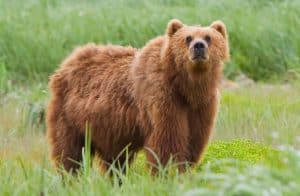 The Kodiak bear (Ursus arctos middendorffi), the largest subspecies of brown bear, is an also known as the Alaskan grizzly bear, though it does not have the “grizzled” fur pattern of the grizzly bear subspecies. The Kodiak bear lives exclusively in the Kodiak archipelago in southwestern Alaska, where it feeds mostly on shoots and plants until the salmon return in the summer.
The Kodiak bear (Ursus arctos middendorffi), the largest subspecies of brown bear, is an also known as the Alaskan grizzly bear, though it does not have the “grizzled” fur pattern of the grizzly bear subspecies. The Kodiak bear lives exclusively in the Kodiak archipelago in southwestern Alaska, where it feeds mostly on shoots and plants until the salmon return in the summer.
Kodiak bears are the largest bears in the world. A large male can stand over 10′ tall when on his hind legs and 5′ when on all four legs. They weigh up to 1,500 pounds.
They are really omnivores (using a variety of foods). They actually spend more time eating grass, plants, and berries than meat. The favorite food the Kodiak bear is fish. Fish are an important part of their diets, but they also chase and kill animals.
13. Moon Bear
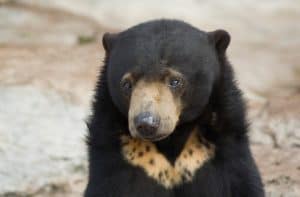 The Asian black bear (Ursus thibetanus), also known as the moon bear (cool name, admittedly) or the white-chested bear, is the second-worst bear. The Asian black bear lives throughout eastern Europe and Asia, as far east as Japan (where it’s known as tsukinowaguma, literally “crescent bear”).
The Asian black bear (Ursus thibetanus), also known as the moon bear (cool name, admittedly) or the white-chested bear, is the second-worst bear. The Asian black bear lives throughout eastern Europe and Asia, as far east as Japan (where it’s known as tsukinowaguma, literally “crescent bear”).
They have the stocky body and large ears which are wide apart on their head. These bear spend around half of time in the trees. They have very powerful upper bodies and front legs for climbing the trees. They usually eat vegetables, fruits, nuts, insects, small mammals, and birds. Like the other bear, males weigh is up to 220g and the females just up to 130 kg. It’s mean that male is larger than female.
14. Boring Brown Bear
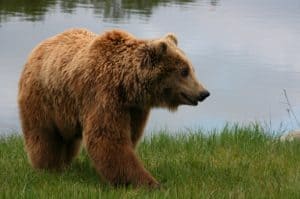 The brown bear has as many as 90 subspecies, all of which are more interesting than the plain-jane Eurasian brown bear (Ursus arctos arctos). The boring brown bear also called the Eurasian brown bear. It’s big and brown and they live all across northern Europe and Asia. They eat anything it can find such as like beehives, birds, crabs, fish, roots, mule deer, etc.
The brown bear has as many as 90 subspecies, all of which are more interesting than the plain-jane Eurasian brown bear (Ursus arctos arctos). The boring brown bear also called the Eurasian brown bear. It’s big and brown and they live all across northern Europe and Asia. They eat anything it can find such as like beehives, birds, crabs, fish, roots, mule deer, etc.
The Eurasia brown bear have varies in size, the biggest male was found to be 1,058 pounds and had a total body length of 8.2 feet. The Eurasian brown bear was used as a fighting animal in Ancient Rome, with the strongest bears coming from Caledonia and Dalmatia.
Now the largest of the population of Eurasian brown bear can be found in the Siberian forests of the Ural mountain range.
15. Marsican Brown Bear
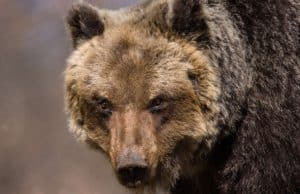 Ursus arctos marsicanus also knows as Marsican brown bear, they are found in the beech forests of the National Park of Abruzzo, Lazio and Molise and surrounding areas. The bear is called an omnivore, its diet consists mainly of plants (grass, fruit, berries, etc…). His favorite is definitely the buckthorn berry (ramus Alpina), which mature in late summer in the mountains of the Park and which makes great feasting.
Ursus arctos marsicanus also knows as Marsican brown bear, they are found in the beech forests of the National Park of Abruzzo, Lazio and Molise and surrounding areas. The bear is called an omnivore, its diet consists mainly of plants (grass, fruit, berries, etc…). His favorite is definitely the buckthorn berry (ramus Alpina), which mature in late summer in the mountains of the Park and which makes great feasting.
The male of the Marsican brown bear is generally much larger than females. It can exceed 2 meters in height for males and the females are considered more little. The mating season falls in late spring (May-June), during this period, the males follow the female for several weeks, trying to prevail over his rival and win the sympathies of the bear.
The cubs are born in the winter period. They usually stay with the mother for about a year and a half, and during this period the mother will raise them with care and attention. The population of these bear is about 40-60.
Differences Between Male and Female Polar Bears
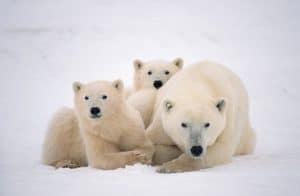 Male and female polar bears are significantly different in size; male polar bears are larger than females, they are growing to a length between 8 and 10 feet while females are only 6 to 8 feet long and for the weight, males are between 550 and 1700 pounds and females only grows between 330 – 650 pounds.
Male and female polar bears are significantly different in size; male polar bears are larger than females, they are growing to a length between 8 and 10 feet while females are only 6 to 8 feet long and for the weight, males are between 550 and 1700 pounds and females only grows between 330 – 650 pounds.
Females start to mate in October or November, most maternity is located on land where snow accumulates including along coastal bluffs, river banks or pressure ridges on sea ice. After mating, the male leaves the female and she alone raises the cubs until they reach about 20-30 pounds before emerging from the den in March or April.
Female polar bears only produce less of five children in their lifetime, which one of the lowest reproductive rates of any mammal.
Population of Polar Bears Nowadays
The most recent International Union for Conservation of Nature (IUCN) report, there are roughly 26.000 polar bears. They are also found in the U.S. (Alaska). Russia, Greenland, and Norway (Svalbard). The IUCN lists the largest threat to polar bear survival are from the climate changes. “There is a high risk of extinction and the threat is serious,” said Dena Cator of the IUCN’s species survival commission. “You could consider polar bears to be a canary in the coal mine.
They are an iconic and beautiful species that is extremely important to indigenous communities. But changes to their sea ice habitat are already being seen as a result of climate change.” Research shows that it’s not too late to take action to save sea ice and polar bears by greatly reducing greenhouse gas emissions. These simple steps will soon become habits and, eventually, part of a stewardship ethic that guides your daily choices and informs your everyday decisions.
See Also :